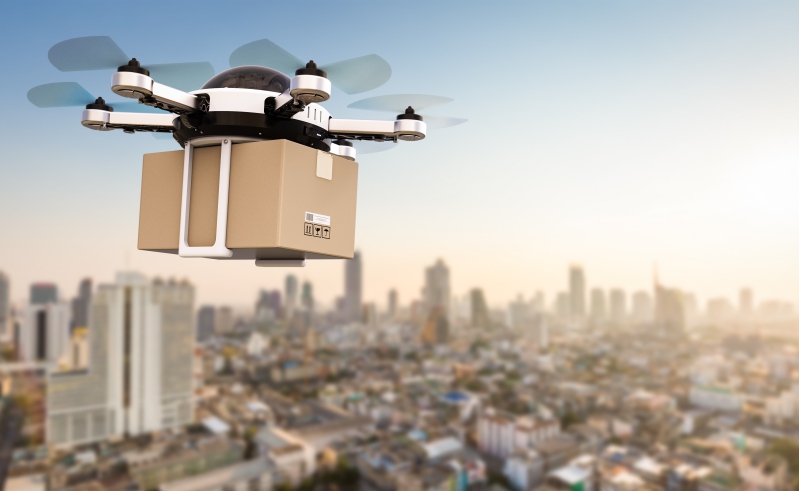
Regulators struggle to balance privacy, security, safety, and innovation in drone regulations.
What if you could order a cup of coffee online and get it at home two minutes later, piping hot with latte art intact?
With the help of drone delivery services, this convenience already exists. In Australia, Google’s drone delivery service has delivered 10,000 cups of coffee, 2,700 sushi rolls, and 1,000 loaves of bread. Google’s drone deliveries typically arrive within 10 minutes, with a record delivery time of 2 minutes and 47 seconds.
Drone delivery offers many benefits for consumers. With speed and convenience, customers can receive their orders from drones at home in minutes. During the COVID-19 pandemic, Google has helped quarantined seniors by providing home deliveries of medications.
By removing people and cars from the delivery process, unmanned drone delivery can benefit society broadly. It can cut operating costs by 90 percent compared to Uber Eats or other car-based delivery systems. Drone delivery can also reduce car-related traffic congestion, accidents, and emissions.
But privacy advocates have raised surveillance and cybersecurity concerns, citing drones’ “nearly unlimited” powers for surveillance. Depending on the drone, it may track GPS location, thermal and infrared information, cell phone data, and people’s faces via cameras and facial recognition.
Chinese manufacturers produce drones that end up in the United States, which may pose national security concerns depending on how the drones collect, store, and secure data. The U.S. Government Accountability Office raised similar privacy concerns.
The Federal Aviation Administration (FAA) regulates commercial drones as part of its mission to provide safe, efficient airspace. FAA officials have suggested, however, that their role does not include regulating privacy issues. Since 2016, the FAA has required anyone with a drone weighing over 0.55 pounds to obtain a remote pilot certificate and follow FAA regulations.
In January, the FAA expanded flexibility for drone operators so that they could operate drones over people, over vehicles, and at night under certain conditions. At the same time, the FAA issued a rule requiring most drones to provide identifying information to address safety, national security, and law enforcement concerns.
This Saturday Seminar focuses on issues to consider when regulating domestic drone use.
- Regulating robots will impact public space, making different places “more or less public,” Kristen Thomasen of the Peter A. Allard School of Law at the University of British Columbia warns in an article in the Ottawa Law Review. According to Thomasen, regulators should focus on understanding the impact of robots on access to public space for all individuals. Thomasen recommends two ways to shape the regulation of robots in public spaces: lawmakers must put the needs of human access to public spaces over those of robotic systems and be aware of over-regulating robotic systems that enhance community accessibility.
- Privacy regulations for drones should not center on consent because individuals in public spaces cannot consent to drones collecting their information, Hadar Jabotinsky of Tel Aviv University and Michal Lavi of the Hebrew University of Jerusalem argue in an article in the University of Pennsylvania Journal of Constitutional Law. They propose requiring drones to maintain distance from private buildings and avoid looking into or documenting private homes. Jabotinsky and Lavi also recommend obscuring public information by avoiding high-resolution cameras and facial recognition, or using technology to blur faces and other identifying information.
- Given public backlash to government drone policy, Jonathan P. West and several coauthors of the University of Miami surveyed public preferences for a U.S. drone regulatory regime in an article in the American Politics Research Journal. West and coauthors found public support for drone regulation, particularly for protecting privacy and keeping them out of the airspace where airplanes fly. They encourage continued surveys of public opinion to better understand how it forms and changes as disruptive new technologies, such as drones, develop and integrate into daily life.
- FAA regulations threaten to stifle drone technology and drone deliveries through excessive safety restrictions, according to Steve Calandrillo and Jason Oh of the University of Washington School of Law and Ari Webb of the Stratford Company in an article in the Stanford Technology Law Review. They urge the FAA to scale back regulations that restrict drone use to the area within operators’ visual line of sight. They recommend allowing pilots to use first-person view or similar technology that transmits drone images to the operator, allowing pilots to operate them from miles away.
- Experts fear drone technology is moving faster than federal legislation and recommend state legislators take action. In a recent report, Brent Skorup of the Mercatus Center at George Mason University and Connor Haaland of Harvard Law School surveyed drone laws in all 50 states and found uncertainty between the role of state and federal governments in managing drone air traffic. Skorup and Haaland explain that states and cities retain police powers over land use and zoning, which includes low-altitude airspace where many drones fly. To facilitate commercial drone use, they recommend that state and local leaders engage in more drone operations than in previous aviation matters.
- Multiple agencies must help with the rollout of drones that deliver medical supplies, argue Robert F. Graboyes and Darcy Nikol Bryan of the Mercatus Center at George Mason University with former U.S. Department of Defense employee John Coglianese in an article from the Mercatus Center. Regulating drones for medical use must include guidance in the diverse areas of medical care, homeland security, and communications between drones and people on the ground. So, medical drone oversight will involve input from agencies such as the U.S. Department of Health and Human Services, the Federal Communications Commission, and the U.S. Department of Transportation. Graboyes, Bryan, and Coglianese acknowledge that these agencies must balance technological effectiveness with reliability and public safety.
The Saturday Seminar is a weekly feature that aims to put into written form the kind of content that would be conveyed in a live seminar involving regulatory experts. Each week, The Regulatory Review publishes a brief overview of a selected regulatory topic and then distills recent research and scholarly writing on that topic.



